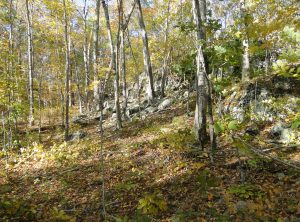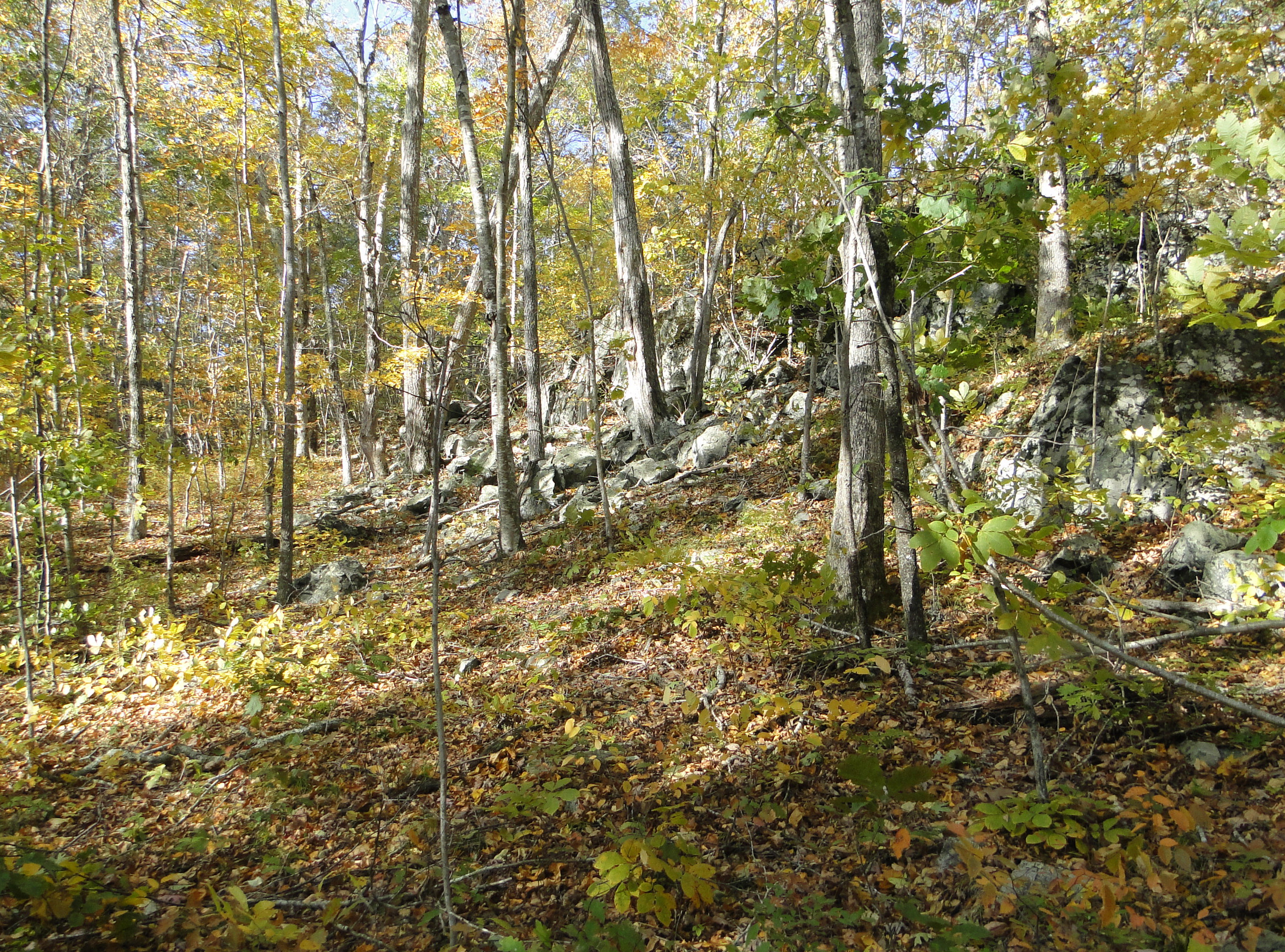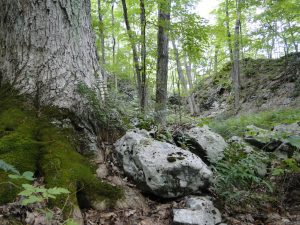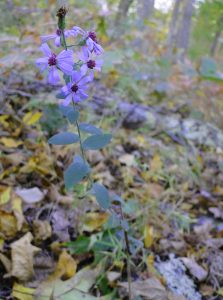Av alonia Land Conservancy is the proud steward of the 527-acre TriTown Forest Preserve in southeastern Connecticut. Well buffered by extensive additional protected open space, including Natchaug State Forest, this preserve not only has a wide range of pristine wetland classes. It also has rugged hills with cliffs, ledges, talus slopes, plateaus, shallow-to bedrock soils, and rocky summits. Forest cover includes well-drained deciduous forest, moist to wet bottomland forest, and mixed hardwood evergreen forest, and ridgetop oak blueberry woodlands. These habitats are accessible to the general public via a well-marked trail system. Four annotated photo-albums provide virtual guided nature hikes. The Preserve website has an excellent trail map and other useful information. https://avalonia.org/tritown-forest/
alonia Land Conservancy is the proud steward of the 527-acre TriTown Forest Preserve in southeastern Connecticut. Well buffered by extensive additional protected open space, including Natchaug State Forest, this preserve not only has a wide range of pristine wetland classes. It also has rugged hills with cliffs, ledges, talus slopes, plateaus, shallow-to bedrock soils, and rocky summits. Forest cover includes well-drained deciduous forest, moist to wet bottomland forest, and mixed hardwood evergreen forest, and ridgetop oak blueberry woodlands. These habitats are accessible to the general public via a well-marked trail system. Four annotated photo-albums provide virtual guided nature hikes. The Preserve website has an excellent trail map and other useful information. https://avalonia.org/tritown-forest/
Links to four annotated photo albums document four early fall field trips, gathering data for a botany report to Avalonia Land Conservancy. They show the plant communities in this large interesting Preserve in Southeastern Connecticut, with gabbro bedrock.
Gabbro Country – Album 1: September Walk in Tritown Preserve
Gabbro Country – Album 2: Low Hills West of Swain Mountain
Gabbro Country– Album 3: Towards Lambert Ridge from the South
Gabbro Country – Album 4: Rixtown Mountain
The albums were generated using Facebook, but are now accessible to anyone via this CaryaEcological.com website.
The underlying bedrock of the TriTown Forest Preserve is Connecticut’s only major formation of Preston gabbro. formation). This an ancient igneous, mafic bedrock, with minerology closely akin to basalt, weathering into mineral-rich soils. Habitat at the base of gabbro cliffs is fed by mineral-rich seepage, and able to support “rich -site” plants.
Due to their much greater age, the gabbro hills in the TriTown Forest Preserve and its surroundings are more severely weathered than the basalt and diabase ridges in the Metacomet Ridge. The low, flat-topped hills, blanketed with acidic glacial till, have typical soil for the state’s eastern Highlands: acidic and infertile, though rich in humus. However, the higher hills still have areas with sub-acidic, base-rich soils, and groundwater seepage through gabbro soil parent materials is still calcium-rich, resulting in slope-base soils that are mineral-rich and circum-neutral. Gabbro ridges support localized minerotrophic plant communities, comparable to those on traprock habitats in central Connecticut. Although they may support unusual and uncommon plant species, gabbro habitats also support healthy populations of regionally common species, and the insect and wildlife populations that depend on them.
The summit/upper slope plant communities were a focus of a 2019 botanical study led by Carya Ecological Services and the CT Botanical Society. Certain dominant and characteristic plants were present on well-drained gabbro hilltops throughout the site, regardless of elevation. This includes Lambert Peak and the crest of Rixtown Mountain, both over 500 feet in elevation. Well-drained upper slopes and plateaus, and foothills had a maximum height of 300 to 400 feet. These anchor species include pignut hickory, white oak, black oak, red cedar, sugar maple, Penn sedge, and heaths (black huckleberry and low blueberry). The most diverse plant species assemblages were at the highest elevations and in cliff-base talus, which also supported massive sugar maples .
Shallow bedrock increases the frequency of tree blowdowns, regularly creating new openings, and helps to maintain high species diversity in summit habitats. (Pickett & White, 1985) Rocky summits usually have tawny patches with little blue stem grass. Upper slopes usually have an open understory, with a “lawn” of Penn sedge, scattered maple leaf viburnum, and scattered large boulders. Especially at the high elevations, many other wildflower and native grass and sedge species are interspersed.On level plateaus along the ridges, stunted trees and saplings are typically widely spaced within a broad, low patch of twiggy heaths, as shown in the photo below.
Concentrations of interesting herbs often occur beneath red cedars, an observation warranting further study. These included hairy bedstraw, ebony spleenwort, smooth whitlow grass, red columbine, dwarf saxifrage, wild oat grass (Danthonia spicata), panicled hawkweed, wavy-leaved aster, rue anemone, blue goldenrod, gray goldenrod, and silverrod.
Symphiotrichum undulatum (wavy-leaved aster)
Other species occurred only in one or two sizable patches, e.g. lopseed, hoary mountain mint, Bosc’s rosette panic grass, and bear oak. Uncommon low shrub and herb species with very limited occurrence in the TriTown Forest Preserve include Carolina rose, dwarf chinquapin oak, skunk meadow rue, rock muhle (Muhlenbergia sobolifera), Lyre-leaved rock cress and stiff rock cress. The two cresses are important host plants for a rare butterfly species, the orange-tip falcate butterfly. Blunt-leaved woodsia was found in only one cliff-top location. Summits also support scattered dwarf Carolina roses and occasional small individuals of an unknown hawthorn species, too young to be identified – a puzzle for future investigation.
Moss and lichen flora are also important in sunny or partly shaded summit habitats. Drought-tolerant mosses such as juniper haircap moss (Polytrichum juniperus) are early colonizers of bare, shallow soil, and help to build up organic matter levels. Hedwigia cilata, medusa moss, is a partially shade-tolerant moss found on a large boulder face. Schistidium apocarpon (rock beard moss) is another boulder moss that tolerates dry conditions. Crustose lichens are on exposed rock surfaces – boulders, cliff faces, and bedrock outcrops. These include rock shields, in the Flavoparmelia and Xanthoparmela genera, and smaller species such as the smokey blue-eyed lichen, Porpidia albcaerulescens. Lichen rhizoids which penetrate rock crevices, and secretions such as oxalic acid help to weather bedrock and release the minerals needed by plants.
Also encountered in open, sunlit gabbro summits are occasional plants, such as smartweeds, hawkweeds, fleabanes, common mullein, or hawk weeds, that are typically found, as well, on trailsides and other open disturbed areas. Wavy-leaved aster is an example of a native aster found in two habitats: trailsides and gabbro summits. Others are exotic species, but still useful for pollinators, and as seed producers for wildlife. They are poor competitors, but fecund, and able to colonize open, disturbed sites.
In this gabbro ridge system, invasive plant colonizers were absent or extremely sparse in 2019, after a very thorough invasive plant eradication program during the prior year. Mugwort would thrive on gabbro summits and rock outcrops but has not reached this preserve. With the steadily increasing usage of the preserve by hikers, annual early summer checks for mugwort seedlings are recommended, so they can be pulled before establishment of rhizomes that would sprout again, after pulling.
**********************************************************************************


